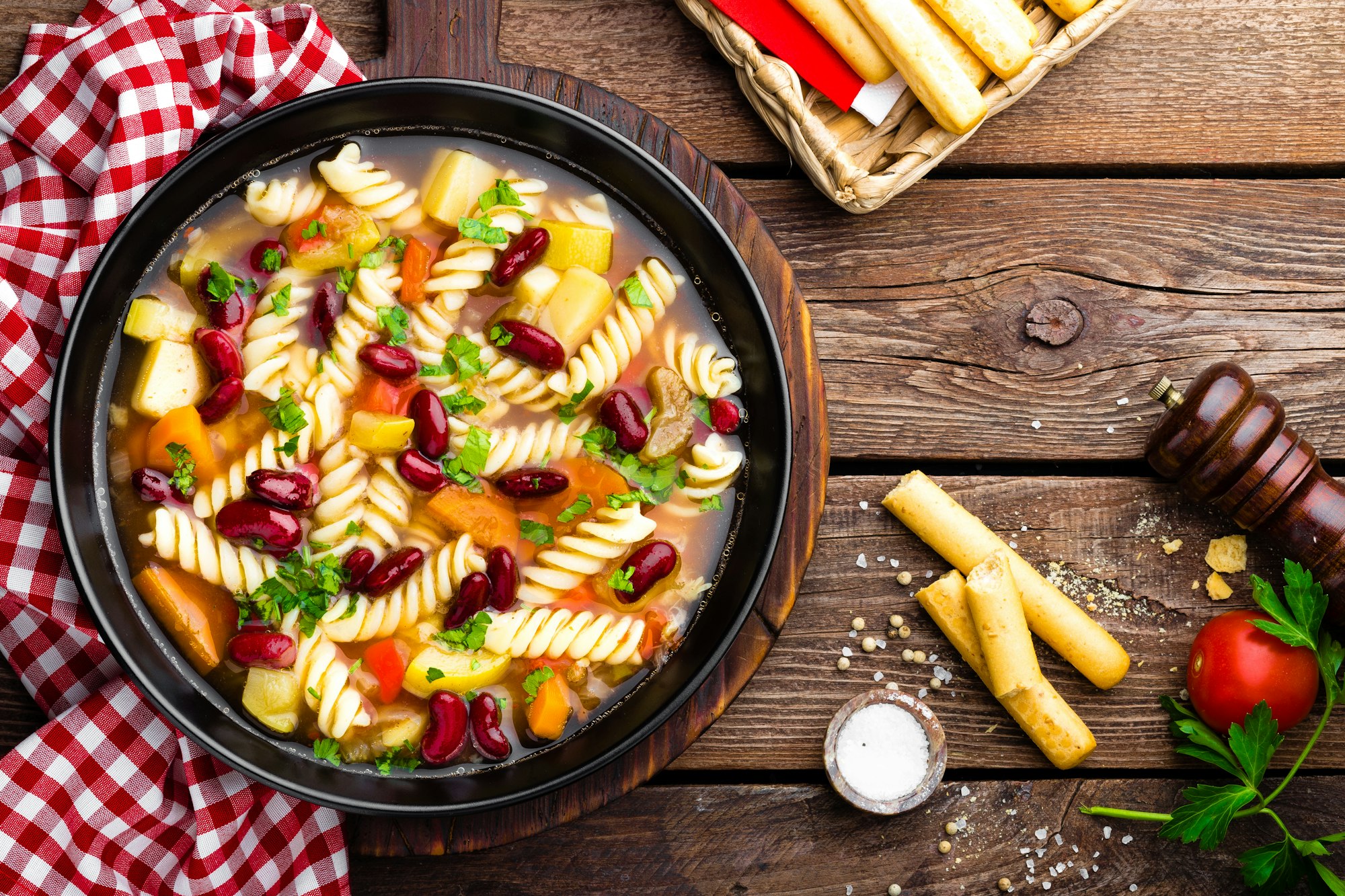What Are the Secrets to a Rich Italian Minestrone with Seasonal Vegetables and Pesto?

A bowl of steaming hot soup can truly be a simple pleasure in life. Especially when that soup is a rich minestrone with a perfect blend of veggies, pasta, and a hint of fresh pesto. This hearty Italian soup is the epitome of comfort food. Though the ingredients list may vary according to the season and regional variations, the backbone of a good minestrone is always vegetables and pasta cooked in a flavorful broth. In this article, we will delve into the secrets of this Italian delicacy, and share with you our favorite minestrone recipe.
The Magic Lies in Fresh Seasonal Vegetables
Any Italian grandmother will tell you that the secret to a good minestrone is to use fresh, seasonal vegetables. This classic Italian soup is perfect for making use of whatever is fresh, abundant and in season. In spring, add peas and young spinach; in the summer, toss in zucchini and bell peppers; autumn calls for pumpkin and kale; while winter might see you adding cabbage and celery.
Avez-vous vu cela : Can You Prepare a Gourmet Indian Biryani with Saffron-Infused Rice and Marinated Chicken?
To allow the flavors of these vegetables to truly shine, it’s essential to cook them properly. Begin by sautéing onions, carrots, and celery in a bit of olive oil. These three ingredients, known as "soffritto" in Italian cuisine, form the flavor base for many dishes. Add the rest of the vegetables in stages, giving each one time to cook and release their flavors. Beans, a common ingredient in minestrone, can be added last as they hold their shape even after long cooking times.
The Importance of a Flavorful Broth
The broth is the soul of any soup, and minestrone is no exception. A flavorful broth will not only add depth to the soup, it will also help to marry all the different ingredients and flavors together.
A découvrir également : How to Create a Flavorful Peruvian Ceviche with Fresh Fish and Citrus?
There are two types of broth that can be used in a minestrone – vegetable or meat-based. A vegetable broth can be made by simmering vegetables like carrots, celery, and onions along with herbs for an hour. For a more robust flavor, a meat-based broth made from chicken, beef or bones can be used.
Remember, the secret to a good broth is time. Allow it to simmer for at least an hour, as the slow cooking process extracts all the flavors from the ingredients. Once the broth is ready, strain it and use this flavorful liquid to cook your beans, pasta, and vegetables.
Adding Pasta for Texture and Hearty Satisfaction
Minestrone is not complete without pasta. The pasta adds a delightful chewy texture and makes the soup more filling. Traditionally, small pasta shapes like macaroni, ditalini or orzo are used, but you can experiment with other shapes.
To keep the pasta from becoming soggy, cook it separately until it is al dente, then add it to the soup just before serving. This way, the pasta retains its texture and doesn’t absorb too much of the broth.
Remember, minestrone is a chunky, hearty soup, so it’s crucial to strike the right balance between the amount of vegetables, beans, and pasta. You don’t want the pasta to dominate.
Infusing a Punch of Flavor with Pesto
Pesto, the vibrant green sauce made from fresh basil, garlic, pine nuts, Parmesan cheese and olive oil, is the secret ingredient that elevates a good minestrone to a great one. The fresh, herby, nutty flavor of pesto adds a punch of flavor that really complements the mellow, simmered taste of the soup.
The best time to add pesto is at the end of the cooking process. Simply stir in a few spoonfuls of freshly made pesto into the soup just before serving. The heat from the soup will gently warm the pesto, releasing its aromas and flavors.
Our Favorite Minestrone Recipe
Now that we’ve revealed the secrets behind a flavorful minestrone, it’s time to put them into practice. This recipe calls for a variety of fresh, seasonal vegetables, pasta, beans, a flavorful broth, and of course, pesto.
Start by preparing your soffritto and sautéing it in olive oil. Add the rest of your chosen vegetables in stages, giving each one time to release their flavor. Once all your vegetables are in, add the broth and allow the soup to simmer.
In a separate pan, cook your pasta until it is al dente. Drain and set aside. Meanwhile, prepare your pesto by blending together fresh basil, garlic, pine nuts, Parmesan cheese and olive oil.
When your soup has simmered and the flavors have melded together, stir in the cooked pasta. Just before serving, stir in the pesto. Ladle the soup into bowls, garnish with fresh basil and a sprinkle of Parmesan cheese, and enjoy a bowl of rich, hearty Italian minestrone!
Adapting the Minestrone for Dietary Needs
Understanding the different dietary needs of people is crucial when sharing a soup recipe. Therefore, the beauty of Italian Minestrone soup is how easily it can be adapted for those with specific dietary requirements.
For those on a gluten-free diet, the pasta can be easily substituted with a gluten-free variety. There are many gluten-free alternatives available in the market today, from rice and corn to quinoa and amaranth. Just be sure that the pasta is cooked separately and added to the soup shortly before serving to maintain its texture and prevent it from becoming soggy.
Moreover, for those who follow a vegan diet, the cheese in the pesto can be replaced with nutritional yeast or simply omitted. Nutritional yeast offers a similar umami flavor to Parmesan cheese, making it an excellent alternative. The broth can also be made entirely from vegetables or a good quality shop-bought vegetable broth can be used for convenience.
For people who consume a low-sodium diet, you can control the salt content by making your own broth and using low-sodium canned beans and diced tomatoes in the recipe.
As a result, this versatile Italian Minestrone soup recipe can be adapted to cater to a wide range of dietary needs without compromising on the rich and hearty flavor that it is known for.
Slow Cooker Option for Busy Lives
In today’s fast-paced world, convenience is key when it comes to cooking. Thankfully, this Minestrone soup can be easily adapted for a slow cooker, giving you a delicious and hearty meal with minimal effort.
Start by sautéing your soffritto in olive oil on the stove, then transfer it to your slow cooker. Add your chosen vegetables, give it a good stir, then pour in the broth. Set your slow cooker to low and let it cook for 6-8 hours, or on high for 3-4 hours. This low and slow cooking process allows all the flavors to meld together beautifully.
About 30 minutes before serving, add your cooked pasta and beans to the slow cooker. Remember to stir occasionally to prevent sticking.
Finish the soup by stirring in the pesto just before serving. The slow cooker keeps the soup piping hot, ensuring the pesto releases its heady aroma and infuses the soup with its fresh, herby flavor.
Conclusion: The Endless Possibilities of Italian Minestrone
In conclusion, the true secret to a rich Italian Minestrone soup lies in its adaptability. Its flexible nature allows you to use a range of fresh, seasonal vegetables and make use of what you have on hand. Furthermore, it can cater to various dietary needs and cooking methods.
Whether you prefer a summer minestrone bursting with zucchini and bell peppers or a winter version loaded with hearty cabbage and celery, this soup is a celebration of the season’s bounty.
Therefore, enjoy the process of making this soup. Sautéing the soffritto, simmering the broth, choosing your seasonal vegetables, and stirring in the pesto just before serving. Each step adds to the final symphony of flavors. So gather your ingredients, roll up your sleeves, and prepare to cook a delicious bowl of Italian Minestrone soup. Your taste buds will thank you!
